I have felt the age-old triangle of mother father and child, with the “I” at its eternal core, elongate and flatten out into the elegantly strong triad of grandmother mother daughter, with the “I” moving back and forth flowing in either or both directions as needed.
—Audre Lorde, Zami
With this in mind, I approach Henrik Olesen’s multimedia installation Mr. Knife and Mrs. Fork (2009) and LaToya Ruby Frazier’s exhibition of black-and-white photographs, A Haunted Capital (2013).1 As the two exhibition titles suggest, both artists tackle social relations that exceed the close familial circle and present the family as defined by the materialities of social life as well as by economic, political, and gendered power. Both exhibitions in turn present familial figures not simply in terms of social roles or kinship positions, but as bodies or embodiments. While Olesen asks, how do I make myself a body?, Frazier’s implicit question is, how am I made a body? Her photographs imply certain answers: I am made a body by what can be called the industrial complex, the medical complex, and the family complex. Oleson’s installation, in contrast, issues a recurring claim of “self-production.” Such answers do not mean that Frazier tells a passive story of the “I” while Olesen tells a more active one. Especially in photographs that Frazier develops in a “wrestling” collaboration with her mother, we see how the triad empowers for agency without neglecting conflict. Similarly, in Olesen’s work self-production ultimately amounts to a de-privileging of the autonomous self, since the “I” is opened up to nonlinear time and nonhuman animacies that reconceptualize it.
Thus, both Frazier and Olesen’s works perform chrono-political interventions in order to disrupt the normalcy of a heterosexual, white, able-bodied family. In performing such interventions, Frazier and Olesen open up the ambiguous and latently violent family stories they present to what José Esteban Muñoz calls “queer potentiality.”2 Muñoz acknowledges the fact that structural violence—encompassing racism, heterosexism, capitalism, transphobia, ablelism—is reproduced institutionally and repeats itself in the most intimate encounters. While it cannot simply be overcome, possibilities for social change nevertheless develop from what Muñoz calls “disidentifications,” which are triggered by artworks and performance practices. For Muñoz, queer aesthetics defamiliarizes the familiar and creates a utopian “there and then” that feeds into today’s collective practices. Potentiality is “a mode of nonbeing that is eminent, a thing that is present but not really existing in the present tense.”3 Realized in an artwork, it might invite the viewer to understand the “nonbeing that is eminent” in its actual, lived relevance.
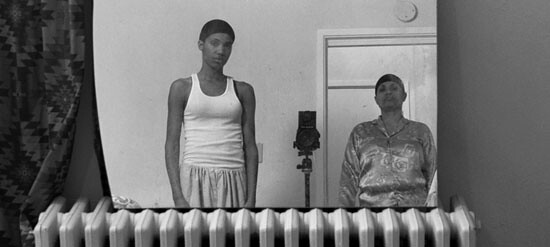

The elegantly strong triad appears in Frazier’s photograph Mom Making an Image of Me (2008), with mother and daughter seen reflected in a mirror. The queer moment of a future that is already present evolves from the camera, itself reflected in the mirror and pointing directly at the viewer—structurally participating in the triad. Frazier’s image denotes the ambiguous power relations of this triad in various ways; for one, Mom takes up the powerful position of photographer, image-maker, and framer. Yet Mom also includes her own body in the frame, refusing to let her daughter stand alone. The mother’s pose is ambivalent; she stands erect—her back straight, her shoulders stiff, her chin up—like a young recruit trying to claim authority she doesn’t (yet) convincingly embody. She wears a serious gaze; only her shimmering floral blouse disrupts the impression of earnestness she radiates. The daughter, in contrast, adopts a relaxed and leisurely, and also pensive, pose. With Mom and the camera withdrawn in the background, the mirror’s angled position transforms the daughter into a huge, intimidating figure watching from above.
The camera in the mirror forbids me as viewer to align with it; however, in pointing directly at me, it invites me instead to become part of the triad. Yet the camera could itself be included in the triad—a symbol for the next generation of the Frazier family, a new daughter “moving back and forth flowing in either or both directions.” At the same time, the camera also disrupts the direct connection between daughter and mother, signified by the distinct, imaginary diagonal line between their heads. The camera thus functions as a dividing line as well as a connecting object between the two women: the tripod’s legs and the camera’s “head” prolong the genealogy of female ancestry. However, genealogy here is no longer bound to “reproductive futurism” (Lee Edelman), but values cultural production and “self-representation” (Teresa de Lauretis) as queer-feminist options for creating social life and subjectivity.4
If Frazier’s image locates the strength of the triad in the prolongation of family genealogy, Henrik Olesen’s installation articulates a desire for its destruction. The son, named Angle in one of the works, is the central figure in the family’s narration—“the ‘I’ at its eternal core.” What kind of “I” is this? As we learn from a letter this “I” writes to his parents using cut-out letters pasted on newspaper pages, this “I” wants to rid itself of father and mother. A paragraph from the letter declares:
It is precisely this world of Father + Mother which must go away, it is this world split in two—doubled in a state of constant disunion, also willing a constant unification … around which turns the entire system of this world maliciously sustained by the most somber organization.
For Olesen, as for Lorde, referring to the “age-old triangle” means that “mother father” or “Father + Mother” are turned into an isolated heterosexual couple, with the child separated off. For Olesen, the child is separated off into non-existence: “This child, he is not there. He is but an angle. An angle to come. And there is no angle.” Here, the character claims self-production and asks, how do I make myself a body? This is perhaps best seen as a strategy for survival in an oedipal and heteronormative, yet strangely remote and privatized, world. Accordingly, the exhibition display of Mr. Knife and Mrs. Fork consisted of various familial objects (wooden sculptures, eating utensils, and so forth) strewn about in a bare white cube that carried no trace of the outside world, except for some news articles still legible on the sheets bearing the letter.
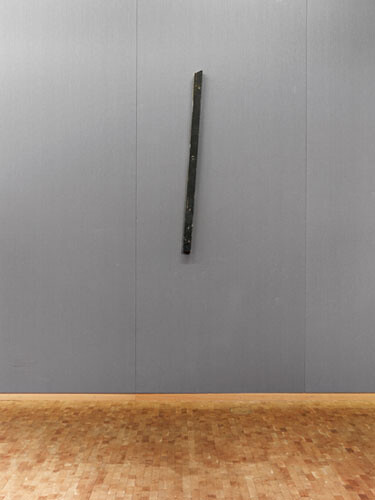

Whereas Oleson presents an isolated self in an almost sterile space, avoiding any specific historical references, in Frazier’s photographs, by contrast, one finds the workings of history—notably of racism and capitalism—even in the most intimate settings. While at first glance her images seem thoroughly domestic, upon further inspection we realize that no family exists apart from its material living conditions. So-called domestic objects, such as the radiator in Mom Making an Image of Me, firmly embed the household in the larger industrial world. The photograph’s dimensions are its most disorienting property: the picture is twice as wide as it is tall. This format spotlights the structural geometry of the radiator, whose ribs resemble the spine of an ancient animal, while simultaneously evoking the history of steel production in Frazier’s hometown of Braddock, Pennsylvania. Thus, the deindustrialization of Braddock forms the first of many frames in Mom Making an Image of Me. Mom also has a (door)frame to herself, mother and daughter share the frame of the mirror, and the image of the two women in the mirror is framed by the curtain, the gray wall, and the radiator. These multiple frames suggest an over-determination of normative structures. The frame defines what is given to be seen, namely, two black women of different ages engaged in a cultural activity that contradicts their attire and surroundings. In combining the overlapping, frames one gets an idea of the tension that characterizes their common practice. Yet, as Kerstin Brandes suggests, we can also see these frames as “unfixing” seemingly stable, stereotypical images—or even the status of the image itself.5 Notably, the near-center of the image (the camera is shifted slightly toward the mother and slightly toward the lower half of the picture) consists of an empty white space, open to receive the various projections that may enter through the ribs of the heater or the window behind the curtain. The frames resemble what are generally understood as norms, but at the same time provide entrance points for the outside world that conditions and undermines the familial privacy.6
Framing also takes place through the exhibition design of A Haunted Capital. The room, entered and exited at opposite ends, began and finished with collaged wallpaper. From afar, this wallpaper appeared as a shimmering pattern of highlights and shadows, dimming the room and providing it with a twilit, cozy atmosphere. As one approached the wallpaper, however, one discovered that it consisted of miniature versions of Frazier’s black-and-white photographs, found materials, documents, and metallic engravings of John Frazier, LaToya Ruby Frazier, Andrew Carnegie (2012), and Diane (2011), an installation made from a framed photograph, a scrap of newspaper, and a pillow on a shelf. Frazier’s black-and-white views of industrial landscapes, demolished buildings, and indoor portrayals of the family constituted the majority of the exhibition.
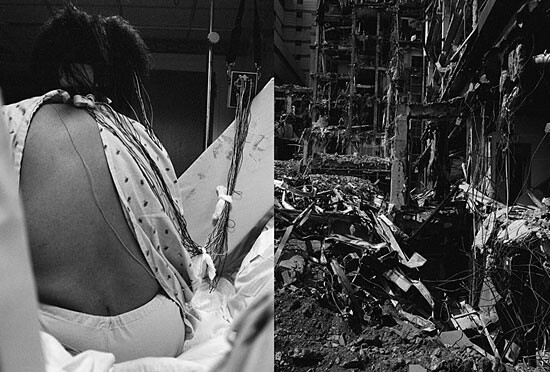

A bare back in a hospital gown, and a bundle of wires connecting the figure’s neck to medical machinery: the image is juxtaposed with another black-and-white photograph showing a demolished high-rise building, whose cluttered steel beams and cables echo the bundle of wires in the adjacent picture. The two photographs ask us to connect illness to (de)industrialization—the town’s toxic factories to the medical problems facing Braddock’s population. Yet the picture also, to take up Brandes’s point, unfixes the frame of reference and retells the story. Instead of presenting patient and ruin as victims of capitalist development, these images become media for an aesthetic process of mimesis that animates the inanimate: cables and beams appear as veins joining bodies, contexts, and experiences. Grandmother, mother, and daughter are knotted together, bound in chains of care that are conditioned by, but do not always comply with, the market. Illness and death are enduring points of reference, yet they also open up a potentiality that is different from the potentiality of profit. Frazier deploys a tension and undecidability between being bound to the past (nostalgic and fearful of what is to come) and an open future (the body that might heal or find ways of living with chronic illness; demolished houses that give way to new buildings, not decay).
The potentiality that Frazier’s work suggests could be called a queer potentiality, if we follow Cathy Cohen, Jasbir Puar, and Fatima El-Tayeb, who insist that queer is not primarily about sexuality, but is about challenging power relations that that can never be separated out in relation to gender, sexuality, race, ethnicity, or class.7 The acknowledgement of entwined power relations means that people always embody this complexity simultaneously, as social beings that encompass a spectrum of abilities (and debilities).
What of this potentiality can be found in Henrik Olesen’s Mr. Knife and Mrs. Fork? When I entered the exhibition space, I encountered mother and father in the form of various wooden slats. Headless and limbless, only the exhibition signs designated the figures’ familial roles. In a far corner of the room were even more profane embodiments of mother and father: mother as a blunt, stubby tin fork and father as a plastic knife, accompanied by their son in the form of a jar of nougat. While the title exploits the symbolic order that safeguards the law of the father, the male put on display in the form of a plastic knife appears quite vulnerable. These surprising embodiments of the age-old triangle, which present the kinship system as consisting of social functions (Mr. Knife and Mrs. Fork) or of stiff, isolated beings (slats, cutlery, glass) that lack organs or abilities to connect, were complemented by another dimension of embodiment—the letter composed on newspaper pages.


Visitors were invited to bend over glass cases containing the thirty newspaper pages that bear the letter. The letter tells a story of personal emancipation. As is appropriate for an emancipation story, a developmental timeline is invoked. However, inspired by a Deleuzo-Guattarian reading of Antonin Artaud, the potential agents of the story, who might grant or disrupt development, instead dissolve into bodies without organs.8 In the letter, the speaking “I” politely (and duplicitously) honors the parents and begs for forgiveness, only to then negate their existence or call for their ejection. The choice of fonts mirrors these contradictory attitudes: antiquated letters for the direct address “My Dear Mother” and “My Dear Father” (reminiscent of the Christian commandment); bold block letters for the “Farewell” and the “NO”; and ornamental decoration for expressing the parental relationship. Most striking is the use of letters made from acrobatically entangled naked bodies to express disbelief in the holy family narrative: “I DON’T BELIEVE IN FATHER IN MOTHER GOT NO PAPAMUMMY.” Meaning and embodiment merge; letters appear animated as bodies.
In Olesen’s collaged letter, the parents are invited to become bodies without organs. The text promises this as a path to “true freedom.” But why would the appeal be approached through the hubris of self-production? “How could this body have been produced by parents, when by its very nature it is such eloquent witness of its own self-production?” Is this “the I at [the] eternal core” of the age-old triangle that Lorde describes? Or should we instead follow Ariane Müller’s assessment in the exhibition catalogue and argue that Olesen’s work portrays an elongation and flattening out of the eternal triangle? With this “I” musing about self-production, we find ourselves in Deleuze and Guattari’s register of the n−1, a singularity derived not from a universal through adding something, but rather through subtracting the universal or general element. Müller explains this de-generalization:
The −1 for Henrik Olesen is often himself. Although this constitutes his work: who and in whom or what he is, in which body, in which sexuality, in which constellation, even in which family, composition, imagination, cell, language, youth. Yet he is subtracted from this. The self and the I subtracted. Even there, where the I is, is −1.9
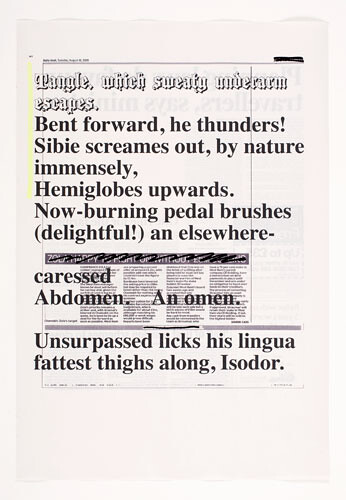

Still, even if there is a reference to Deleuze and Guattari’s body as an assemblage of the animate and the inanimate, the material and the symbolic, Olesen’s “I” arrives at a singularity, left alone with the question of who one is and where one comes from. In Olesen, the racially unmarked body turns out to be a white body, aligning with an “I” that does not hesitate to employ racist stereotypes—for example, through grounding an argument in combining “malicious” and “somber.” Or in the statement “Better to sleep with a sober cannibal than a drunken Christian.” This remark comes from the protagonist while embroiled in a conflict with his parents, which follows a sexist scenario involving Sibie (mother) and Isidor (father) (the only time the parental figures appear with names). The scene of marital rape is presented through poetic lyrics, oscillating strangely between violence and pleasure. Yet the lyrics expose a rhetorical strategy that aims at naturalizing dominance: “A natural bent, no doubt Bent forward, he thunders! … Sibie screams out, by nature immensely … (delightful!) an elsewhere—caressed.” The devastating scene is assessed critically by Olesen’s protagonist with equally critical racist pronouncement. So, while one can argue that it is courageous for Olesen to show in Mr. Knife and Mrs. Fork how domestic violence works through an alignment with delight (whose delight?), the son’s reaction pits racism against sexism and reproduces racist stereotypes (however ironically).
The son’s letter ends with a page presenting a “POEM TO THE HOLE IN THE ASS.” The page is designed meticulously, the sentences arranged to represent the star-like folds of an asshole. Since the parents were invited to transform themselves into organless bodies seven pages before, the ode to anal sex could apply to them just as much as to their son. The old triangle might flatten out now, thanks to the democratic hole that anyone may claim as a site of sexual pleasure: “Dark and puckered like a violet rose it pulses, humbly hidden amidst the moss.” This pleasure, historically opened up through the courage of gay male public explicitness, may also promise sexual justice for the heterosexual couple, freeing the “I” from its oedipal role in the nuclear family.
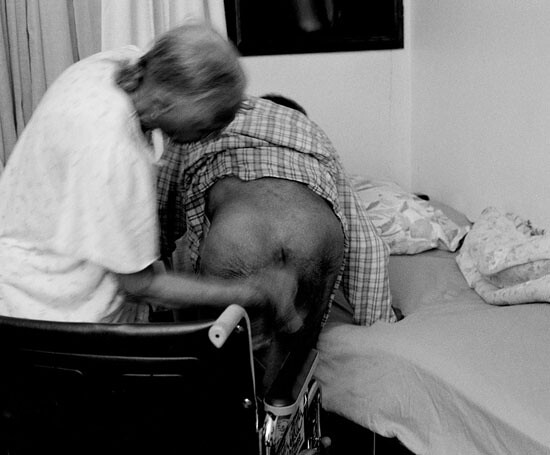

Unforeseen, a photograph by Frazier takes up this tune and alters it in a stunning way: an intimate, caring scene in which grandfather bends over (without her thundering) so that grandmother can wipe his ass. Given the ongoing history of white people exploiting service work done by black people, it is perhaps unsurprising that a black body is depicted administering care. Yet, it is significant that the care here is of another black body. The care act is depicted in such a way that the blurred twirl of the hand and cloth gives the impression of an erotic gesture rather than a hygenic function. What does it mean to be invited as a viewer to witness this intimate encounter? What does it mean for a viewer who is positioned differently in relation to the power structures implicit in matters of race, class, and gender to watch this scene?
In the photographs presented in Haunted, Frazier relates a history of a highly racialized political economy by zooming in on the intimacy between grandmother, mother, and daughter. Frazier’s grandma Ruby and granddaughter Ruby not only share the same name, but they also inhabit a shared world of meaningful details—objects assembled over decades or even generations, revealing a racialized, classed, and gendered connectivity. In Grandma Ruby and Me (2005), which was positioned prominently in the exhibition and was also used in its promotional material, grandmother and granddaughter sit on the carpet of an excessively decorated living room, looking over their shoulders into the camera. Their closeness does not rely on touch, but is instead created by the mirrored pose of their bodies. The viewer is captured at the meeting point of their gazes, forming a sharp triangle. Frazier disables the viewer’s ability to elude familial intimacy, whereas Olesen seals off proximity altogether. The familial battle evinced in the letter prevents the viewer from coming too close.


Frazier is very conscious in her handling of racial and class-based power relations—the way they are built upon racist and capitalist forms of domination and intertwine with gendered dynamics (which unfold in same-sex as well as differentially sexed contacts). In a performance she developed with Liz Magic Laser on the occasion of the opening of a Levi’s jeans photo studio in Braddock, Frazier not only points out the racist underpinnings of the company’s business and advertising strategies, but also makes use of subtle yet daring sexual imagery to cleverly reframe its content.10 In this performance, Frazier uses her body to rhythmically rub and scrub the concrete pathway in front of the shop. Her action, which first chafes and then destroys the jeans, has a clear sexual connotation: “FUCK YOU.” Yet it says this without employing gestures of penetration. Instead, Frazier uses imagery that connects caressing to masturbatory pleasure. We can see this vocabulary as being democratizing, in the same vein as anal sex.
Through unfixing and relocating dominant frames, Olesen’s Mr. Knife and Mrs. Fork and Frazier’s A Haunted Capital undermine the centrality of the “the age-old triangle of mother father and child.” They instead present chrono-political interventions that invite the future into the present—deindustrialization in Frazier, and emancipation in Olesen—while simultaneously confusing the developmental timelines. The “I”—moving yet captured, captured yet moving in a relational net that is no longer triangle nor triad—struggles against familial bonding/bondage. Yet the “I” is also always already engaged in reworking sociohistorical power relations. In Muñoz’s words, Frazier and Olesen enact a poetics of queer potentiality. Olesen, in his work, portrays something that does not exist in the present, yet is notably there as an aesthetic experience: PAPAMUMMY end their symbiotic state of constant disunion, throw off their oedipal roles, and ally with the child’s anal and other pleasures. Frazier creates “Grandma Ruby, Mom and myself as one entity,”11 without losing an “I” that has the power to transform the socially uneven assemblages of urban family life.
Henrik Olesen’s Mr. Knife and Mrs. Fork was first exhibited at Studio Voltaire (London) in 2009. The version I discuss in this essay was exhibited at Museum Ludwig (Cologne) in 2012. Olesen’s exhibition is also represented in the catalogue How Do I Make Myself A Body?, eds. Nikola Dietrich and Jacob Fabricius (Ostfildern: Hatje Cantz, 2011). LaToya Ruby Frazier’s A Haunted Capital, organized by Eugenie Tsai and John and Barbara Vogelstein, took place at the Brooklyn Museum (New York City) in 2013.
José Esteban Muñoz, Cruising Utopia: The Then and There of Queer Futurity (New York: New York University Press, 2009.
Ibid., 9.
Lee Edelman, No Future. Queer Theory and Death Drive (Durham, NC: Duke University Press, 2004); Teresa de Lauretis, Technologies of Gender. Essay on Theory, Film, and Fiction (Indiana UP 1987).
Kerstin Brandes, Fotografie und “Identität”. Visuelle Repräsentationspolitiken in künstlerischen Arbeiten der 1980er und 1990er Jahre (Bielefeld: transcript 2010).
For more on the normative and normalizing effects of the frame, see Judith Butler, “Folter und die Ethik der Fotografie,” in Bilderpolitik in Zeiten von Krieg und Terror. Medien, Macht und Geschlechtenverhältnisse, ed. Linda Hentschel (Berlin: b_books, 2007), 205-27; Jacques Derrida, “The Parergon,” in The Truth in Painting (Chicago: University of Chicago Press, 1987); and Sigrid Schade und Silke Wenk, Studien zur visuellen Kultur (Bielefeld: transcript, 2011).
Cathy Cohen, “Punks, Bulldaggers, and Welfare Queens: The Radical Potential of Queer Politics?” in Black Queer Studies: A Critical Anthology, eds. Patrick E. Johnson and Mae G. Henderson (Durham, NC: Duke University Press, 2005), 21-51; Jasbir Puar, Terrorist Assemblages: Homonationalism in Queer Times (Durham, NC: Duke University Press, 2008); Fatima El-Tayeb, European Others: Queering Ethnicity in Postnational Europe (Minneapolis: University of Minnesota Press, 2011).
Antonin Artaud’s radio play To Have Done with the Judgment of God (1947) is reprinted in How Do I Make Myself A Body? (134-139). This play inspired Gilles Deleuze and Felíx Guattari to develop their concept of the body without organs.
Ariane Müller, “U as in One,” in How Do I Make Myself A Body?, 80.
The performance is documented in the video “LaToya Ruby Frazier Takes On Levi’s” (2011).
See →.
